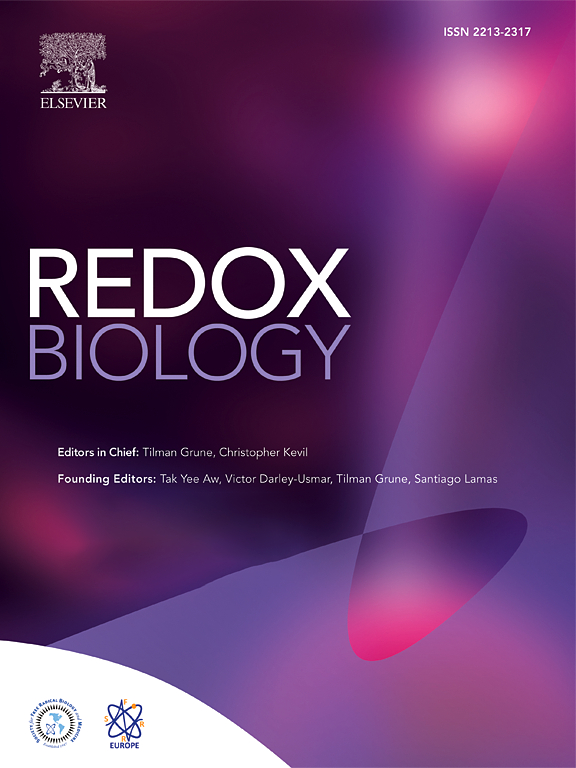Effect of alternative oxidase (AOX) expression on mouse cerebral mitochondria bioenergetics
IF 10.7
1区 生物学
Q1 BIOCHEMISTRY & MOLECULAR BIOLOGY
引用次数: 0
Abstract
Alternative oxidase (AOX) is an enzyme that transfers electrons from reduced quinone directly to oxygen without proton translocation. When AOX from Ciona intestinalis is xenotopically expressed in mice, it can substitute the combined electron-transferring activity of mitochondrial complexes III/IV. Here, we used brain mitochondria from AOX-expressing mice with such a chimeric respiratory chain to study respiratory control bioenergetic mechanisms.
AOX expression did not compromise the function of the mammalian respiratory chain at physiological conditions, however the complex IV inhibitor cyanide only partially blocked respiration by AOX-containing mitochondria. The relative fraction of cyanide-insensitive respiration increased at lower temperatures, indicative of a temperature-controlled attenuation of mammalian respiratory enzyme activity.
As AOX does not translocate protons, the mitochondrial transmembrane potential in AOX-containing mitochondria was more sensitive to cyanide during succinate oxidation than during malate/pyruvate-supported respiration. High concentrations of cyanide fully collapsed membrane potential during oxidation of either succinate or glycerol 3-phosphate, but not during malate/pyruvate-supported respiration. This confirms AOX's electroneutral redox activity and indicates differences in the proton-translocating capacity of dehydrogenases upstream of the ubiquinone pool. Our respiration data refutes previous proposals for quinone partitioning within the supercomplexes of the respiratory chain, instead supporting the concept of a single homogeneous, freely diffusing quinone pool.
Respiration with either succinate or glycerol 3-phosphate promotes reverse electron transfer (RET) towards complex I. AOX expression significantly decreased RET-induced ROS generation, with the effect more pronounced at low temperatures. Inhibitor-sensitivity analysis showed that the AOX-induced decrease in H2O2 release is due to the lower contribution of complex I to net ROS production during RET.
Overall, our findings provide new insights into the role of temperature as a mechanism to control respiration and highlight the utility of AOX as a genetic tool to characterize both the distinct pathways of oxygen reduction and the role of redox control in RET.
替代氧化酶(AOX)的表达对小鼠大脑线粒体生物能的影响。
另类氧化酶(AOX)是一种将电子从还原醌直接转移到氧而不需要质子转移的酶。当在小鼠体内异种表达来自肠道弧尾柱虫的 AOX 时,它可以替代线粒体复合物 III/IV 的联合电子传递活性。在这里,我们利用 AOX 表达小鼠的脑线粒体和这种嵌合呼吸链来研究呼吸控制生物能机制。在生理条件下,AOX 的表达不会损害哺乳动物呼吸链的功能,但复合体 IV 抑制剂氰化物只能部分阻断含 AOX 线粒体的呼吸作用。对氰化物不敏感的呼吸作用的相对比例在较低温度下增加,这表明哺乳动物呼吸酶活性的衰减是受温度控制的。由于 AOX 不转运质子,因此在琥珀酸氧化过程中,含 AOX 线粒体的线粒体跨膜电位对氰化物的敏感性高于苹果酸/丙酮酸支持的呼吸过程。在琥珀酸或 3-磷酸甘油氧化过程中,高浓度氰化物会完全崩溃膜电位,但在苹果酸盐/丙酮酸盐支持的呼吸过程中不会。这证实了 AOX 的电中性氧化还原活性,并表明泛醌池上游脱氢酶的质子转移能力存在差异。我们的呼吸作用数据驳斥了以前关于在呼吸链超级复合物中分配醌的建议,而支持单一均质、自由扩散的醌池的概念。使用琥珀酸或 3-磷酸甘油进行呼吸作用会促进向复合体 I 的反向电子转移(RET)。AOX 的表达明显减少了 RET 诱导的 ROS 生成,在低温条件下效果更为明显。抑制剂敏感性分析表明,AOX 诱导的 H2O2 释放减少是由于在 RET 过程中复合物 I 对净 ROS 生成的贡献较低。总之,我们的研究结果为了解温度作为一种呼吸控制机制的作用提供了新的视角,并突出了 AOX 作为一种遗传工具在描述不同的氧还原途径以及氧化还原控制在 RET 中的作用方面的实用性。
本文章由计算机程序翻译,如有差异,请以英文原文为准。
求助全文
约1分钟内获得全文
求助全文
来源期刊

Redox Biology
BIOCHEMISTRY & MOLECULAR BIOLOGY-
CiteScore
19.90
自引率
3.50%
发文量
318
审稿时长
25 days
期刊介绍:
Redox Biology is the official journal of the Society for Redox Biology and Medicine and the Society for Free Radical Research-Europe. It is also affiliated with the International Society for Free Radical Research (SFRRI). This journal serves as a platform for publishing pioneering research, innovative methods, and comprehensive review articles in the field of redox biology, encompassing both health and disease.
Redox Biology welcomes various forms of contributions, including research articles (short or full communications), methods, mini-reviews, and commentaries. Through its diverse range of published content, Redox Biology aims to foster advancements and insights in the understanding of redox biology and its implications.
 求助内容:
求助内容: 应助结果提醒方式:
应助结果提醒方式:


